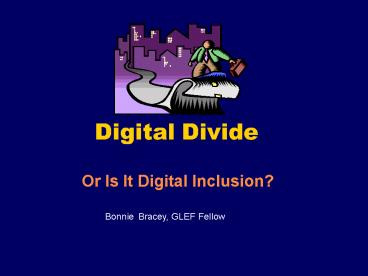Digital Divide - PowerPoint PPT Presentation
1 / 16
Title:
Digital Divide
Description:
FREE PRESS COLUMNIST. Michigan's teachers are confident they can use technology to learn. ... in Detroit and a 2001 winner of the Milken Educator Award, given ... – PowerPoint PPT presentation
Number of Views:61
Avg rating:3.0/5.0
Title: Digital Divide
1
Digital Divide
- Or Is It Digital Inclusion?
Bonnie Bracey, GLEF Fellow
2
Your Definition of Digital Divide?
3
Digital Divide? What is it?
- Many people ignore the digital divide.. they say
it is black, vs. white, and or rural vs. distant.
- Some say it is minority vs rich, or the US vs the
rest of the world and that it will gradually
filter down to those who are have and have not.
4
Digital Divide? What is it?
- Some see the technology as male with some
involvement of women. - Some define who is involved by age.
5
Data on Inclusion?
- For example, the August 2000 data show that
noticeable divides still exist between those with
different levels of income and education,
different racial and ethnic groups, old and
young, single and dual-parent families, and those
with and without disabilities.
6
Data on Inclusion?
- Persons with a disability are only half as likely
to have access to the Internet as those without a
disability 21.6 compared to 42.1. And while
just under 25 of those without a disability have
never used a personal computer, close to 60 of
those with a disability fall into that category.
7
Data on Inclusion?
- Large gaps also remain regarding Internet
penetration rates among households of different
races and ethnic origins. Asian Americans and
Pacific Islanders have maintained the highest
level of home Internet access at 56.8. Blacks
and Hispanics, at the other end of the spectrum,
continue to experience the lowest household
Internet penetration rates at 23.5 and 23.6,
respectively.
8
Now to think about it?
9
Definitions!
- We use the term "digital divide" to refer to this
gap between those who caneffectively use new
information and communication tools, such as
theInternet, and those who cannot. - While a consensus does not exist on theextent
of the divide (and whether the divide is growing
or narrowing),researchers are nearly unanimous in
acknowledging that some sort of divide exists at
this point in time.
10
Computers used more to learn than teach! BY
HEATHER NEWMANFREE PRESS COLUMNIST
- Michigan's teachers are confident they can use
technology to learn. But most aren't sure they
can use technology to pass on that learning to
their students. - So says a survey of 90 percent of the state's
teachers, the largest poll of its type to be
conducted in the United States.
11
Computers used more to learn than teach!
- The survey, taken by Michigan Virtual University
as part of a program to give every Michigan
teacher a laptop computer, strikes at the heart
of the debate surrounding technology in schools. - Now that billions of dollars have been spent to
put computers in classrooms, the question becomes
whether teachers are prepared to use them.
12
Computers used more to learn than teach!
- Most teachers in the survey said they could get
information from the Web, send e-mail and
participate in discussion groups with other
educators. But far fewer teachers -- sometimes
only 1 in 9 -- said they could use technology
such as spreadsheets, presentation software,
digital imaging or other high-tech tools to
enhance their lessons.
13
Computers used more to learn than teach!
- "It all boils down to training and techniques,"
said Jeffery Robinson, an instructor at Malcolm X
Academy in Detroit and a 2001 winner of the
Milken Educator Award, given annually by the
Milken Family Foundation. - "The districts aren't making enough effort to
make the bridges" between traditional learning
materials and technology for the teacher, he
said. "For those teachers, it takes more than
giving them a book and a laptop and telling them,
'Go for it.' "
14
EXTEND THE REACH
- FOR THOSE WHO TEACH
15
Resources!
- are available free of charge on the Internet.
- www.digital-equity.org
- www.glef.org
- www.benton.org
- www.exploratorium.org
16
Contact info
- Bonnie Bracey
- Lucas Fellow
- 230 G Street Southwest
- Washington, DC 20024
- Bbracey_at_aol.com































